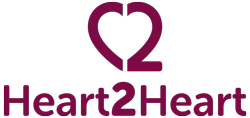Pressures of Blood Flow Within the Heart
Download this information sheet as a PDF
The aim of this information sheet is to provide parents and carers with information and advice about pressures of blood flow within the heart.
The pressure of blood flow within the heart affects the direction and force of the blood as it moves within the body. If the pressure is not as normally expected, it can affect the function of the heart and the circulation of blood.
To understand how the blood flows in and out of the heart, it is important to know that the pressure of the blood flow within each chamber of the heart is different. Normally the pressure on the right side of the heart and in the pulmonary arteries is lower than the pressure on the left side of the heart and in the aorta.
This is because:
- the right side of the heart pumps blue (deoxygenated – little or no oxygen) blood returning from the body back to the lungs. It normally pumps this blue blood at low pressure because it only has to travel the short distance from the heart to the lungs and the lungs are filled with air which creates very little resistance. Therefore the right side of the heart has an easier, lower pressured job.
- the left side of the heart receives the red (oxygenated) blood returning from the lungs. It then pumps this blood to the body at high pressure because it has to drive the blood out from the heart and all the way down to the legs and arms, meeting with resistance from muscles and body tissue on the way. Therefore the left side of the heart has a more difficult, higher pressured job.
Children with heart defects may have:
- a hole between the two pumping chambers of the heart: this means that blood from the high-pressure chamber on the left side of the heart is pumped through the hole to the lower-pressure right side. This extra blood will be pumped to the lungs. A small amount of blood passing from the left to the right sides of the heart does not cause an increase in pressure. However, a large amount of blood will increase the pressure in the right side of the heart. This raises the pressure in the pulmonary arteries. Prolonged high pressure in the lungs (pulmonary hypertension) can cause damage to their more delicate tissues.
- a hole between the two arteries: Before the baby is born the ductus arteriosus (arterial duct or channel), part of the foetal circulation, joins the aorta to the pulmonary artery. If that passage stays open after birth then blood from the high pressure aorta will flow into the lower pressure pulmonary arteries and to the lungs.
Also, if there is an obstruction of a valve (pulmonary stenosis or aortic stenosis) the pressures in the ventricles behind the valve may differ from normal.
For example: Eisenmenger’s syndrome is the name given to a very serious condition where the pressure on the right side of the heart is higher than on the left, as a result of an untreated hole in the heart. This untreated condition leads to deoxygenated blood being pumped from the right side of the heart to the left and then around the body. This leads to a child being cyanosed (displaying blue-tinged skin) and having lower oxygen levels in their blood stream.
With complex defects where a child’s heart does not have a normal circulation, the cardiologist or surgeon may use connections between the aorta and the pulmonary artery to get blood to the lungs or to the body.
Medicine (for example prostaglandin) might be used to keep the ductus open to allow extra pathways for blue and red blood to mix, providing a baby with temporary relief from their symptoms. A shunt (a small plastic tube) might be inserted during an operation to allow the blue and red blood to mix, making the child or baby less blue (more oxygenated). Before a major operation such as a Fontan procedure or Glenn shunt, it is important that the pressures are correct in the various chambers of the heart. Careful measurements are taken during an ultrasound scan (echocardiogram), MRI (Magnetic Resonance Imaging) or cardiac catheterisation.
Evidence and sources of information for this CHF information sheet can be obtained at:
(1) National Institute for Health & Care Excellence. Telemetric adjustable pulmonary artery banding for pulmonary hypertension in infants with CHD. Guidance IPG505. London: NICE; 2017. Available at:
https://www.nice.org.uk/guidance/ipg505
(2) Pulmonary Circulation. Pushing the envelope: a treat and repair strategy for patients with advanced pulmonary hypertension associated with congenital heart disease. Rebecca Johnson Kameny, et al. Vol 7, Issue 3, pp. 747 – 751. First Published September 1, 2017. Available at:
https://doi.org/10.1177/2045893217726086
About this document:
Published: December 2014
Reviewed: May 2022
To inform CHF of a comment or suggestion, please contact us via info@chfed.org.uk or Tel: 0300 561 0065.









